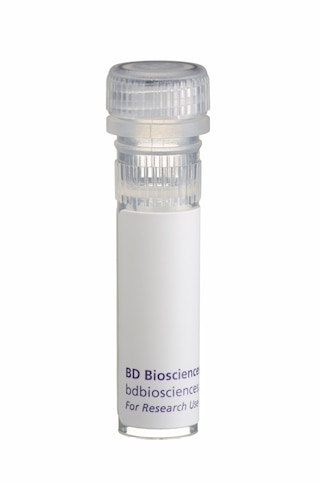Old Browser
This page has been recently translated and is available in French now.
Looks like you're visiting us from {countryName}.
Would you like to stay on the current country site or be switched to your country?




Expression of TNF by stimulated CD4+ and CD4- BALB/c spleen cells. After 6 hour stimulation with hamster anti-mouse CD3 (2 µg/ml final concentration; Clone 145-2C11, Cat. No. 553057) and hamster anti-mouse CD28 (2 µg/ml final concentration; Clone 37.51, Cat. No. 553294) antibodies in the presence of GolgiStop™ (2 µM final concentration; Cat. No. 554724), the splenocytes were stained with FcBlock™ (1 µg/1 million cells; Cat No. 553142), then 0.06 µg of PE-conjugated rat anti-mouse CD4 (PE-RM4-5, Cat. No. 553049). The cells were then fixed, permeabilized, and subsequently stained with 0.06 µg of FITC-conjugated rat anti-mouse TNF antibody (FITC-MP6-XT22, Cat. No. 554418) by using Pharmingen's staining protocol (left panel). To demonstrate specificity of staining, the binding of the FITC-MP6-XT22 antibody was blocked by preincubation of the antibody conjugate with recombinant mouse TNF (0.25 µg, Cat. No. 554589; middle panel), and by preincubation of the fixed/permeabilized cells with unlabeled MP6-XT22 antibody (2 µg, Cat.No. 554416; right panel) prior to staining. The quadrant markers for the bivariate dot plots were set based on the autofluorescence control, and verified with the recombinant cytokine blocking (middle panel) and antibody blocking (right panel) specificity controls.


BD Pharmingen™ Purified Rat Anti-Mouse TNF

Regulatory Status Legend
Any use of products other than the permitted use without the express written authorization of Becton, Dickinson and Company is strictly prohibited.
Preparation And Storage
Recommended Assay Procedures
Recommended Assay Procedure:
Blocking Control for Intracellular Staining: The purified MP6-XT22 antibody (Cat. No. 554416) can be used as a blocking control to demonstrate specificity of TNF protein staining by directly conjugated -MP6-XT22 antibody. To perform this control, the fixed/permeabilized cells (~ 1 million) can be incubated with 1 -10 µg of unlabeled MP6-XT22 antibody (Cat. No. 554416) for 20 minutes at 4°C, prior to staining with directly conjugated antibody (e.g., 0.1 -0.5 µg mAb/1 million cells). The intracellular cytokine staining technique and use of blocking controls are described in detail by C. Prussin and D. Metcalfe. For specific methodology, please visit our web site, www.bdbiosciences.com, and go to the protocols section or the chapter on intracellular staining in the Immune Function Handbook.
ELISA Capture: The purified MP6-XT22 antibody (Cat. No. 554416) is useful as a capture antibody for a sandwich ELISA for measuring mouse TNF protein levels. Purified MP6-XT22 antibody can be paired with the biotinylated polyclonal rabbit anti-mouse/rat TNF antibody (Cat. No 557432) as the detecting antibody, with recombinant mouse TNF (Cat. No. 554589) as the standard. This pair measures total TNF, free TNF as well as TNF bound by soluble receptors.
Note : This ELISA pair is recommended primarily for measuring cytokine from experimental cell culture systems. These ELISA reagents are not recommended for assaying serum or plasma samples. For measuring Mouse TNF in serum or plasma our Mouse TNF BD OptEIA™ Set (Cat. No. 558534) or BD OptEIA Kit (Cat. No. 559732) are specially formulated and recommended.
WB: The MP6-XT22 antibody has been reported to be useful for Western blotting. Please note that this application is not routinely tested at BD Biosciences Pharmingen.
Product Notices
- Since applications vary, each investigator should titrate the reagent to obtain optimal results.
- Please refer to www.bdbiosciences.com/us/s/resources for technical protocols.
- Caution: Sodium azide yields highly toxic hydrazoic acid under acidic conditions. Dilute azide compounds in running water before discarding to avoid accumulation of potentially explosive deposits in plumbing.
The MP6-XT22 antibody specifically binds to mouse Tumor Necrosis Factor (TNF, also known as TNF-α). TNF is produced by many activated cell types including monocytes, macrophages, astrocytes, granulocytes, mast cells, T and B lymphocytes, NK cells, keratinocytes, fibroblasts, adipocytes, and certain tumor cells. Activated cells express type II transmembrane TNF glycoproteins that associate as homotrimeric complexes. After enzymatic cleavage, the extracellular regions of membrane TNF are shed as soluble homotrimers. TNF is a potent multifunctional cytokine that can exert regulatory and cytotoxic effects on a wide range of normal lymphoid and non-lymphoid cells and tumor cells. Although TNF serves as a primary mediator in protective immune responses against microbial and viral pathogens, it can also drive systemic pathophysiologic responses including septic shock, cachexia and autoimmune diseases. Mouse TNF exerts its biological activities by binding and signaling through cell surface membrane Type I and Type II TNF Receptors (aka, TNFRI/CD120a and TNFRII/CD120b, respectively).
This antibody is routinely tested by flow cytometric analysis. Other applications were tested at BD Biosciences Pharmingen during antibody development only or reported in the literature.
Development References (4)
-
Abrams J. Immunoenzymetric assay of mouse and human cytokines using NIP-labeled anti-cytokine antibodies. Curr Protoc Immunol. 2001; 1:6.20-6.21. (Clone-specific). View Reference
-
Abrams JS, Roncarolo MG, Yssel H, Andersson U, Gleich GJ, Silver JE. Strategies of anti-cytokine monoclonal antibody development: immunoassay of IL-10 and IL-5 in clinical samples. Immunol Rev. 1992; 127:5-24. (Clone-specific). View Reference
-
Litton MJ, Sander B, Murphy E, O'Garra A, Abrams JS. Early expression of cytokines in lymph nodes after treatment in vivo with Staphylococcus enterotoxin B. J Immunol Methods. 1994; 175(1):47-58. (Clone-specific). View Reference
-
Prussin C, Metcalfe DD. Detection of intracytoplasmic cytokine using flow cytometry and directly conjugated anti-cytokine antibodies. J Immunol Methods. 1995; 188(1):117-128. (Methodology). View Reference
Please refer to Support Documents for Quality Certificates
Global - Refer to manufacturer's instructions for use and related User Manuals and Technical data sheets before using this products as described
Comparisons, where applicable, are made against older BD Technology, manual methods or are general performance claims. Comparisons are not made against non-BD technologies, unless otherwise noted.
For Research Use Only. Not for use in diagnostic or therapeutic procedures.
Report a Site Issue
This form is intended to help us improve our website experience. For other support, please visit our Contact Us page.
